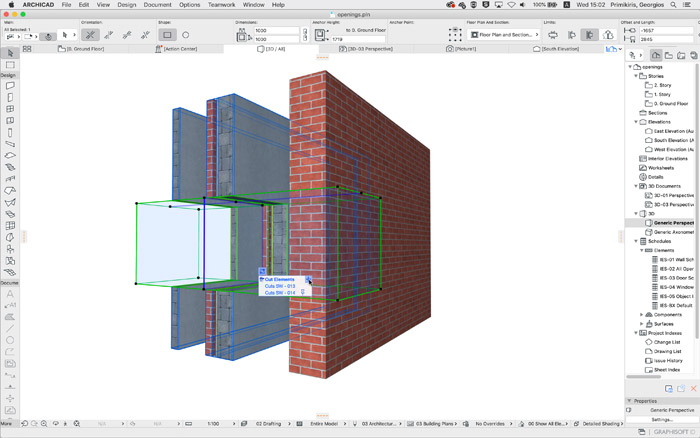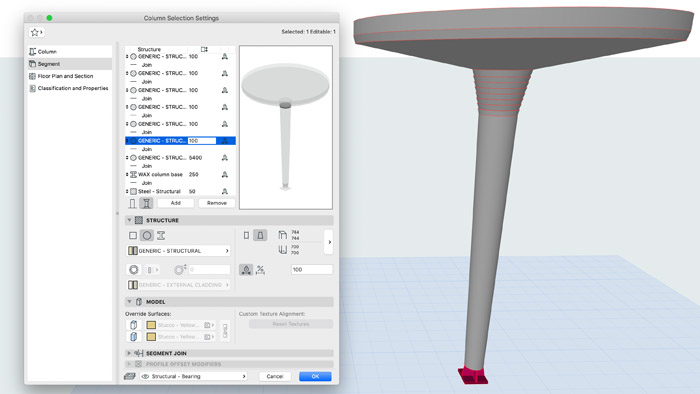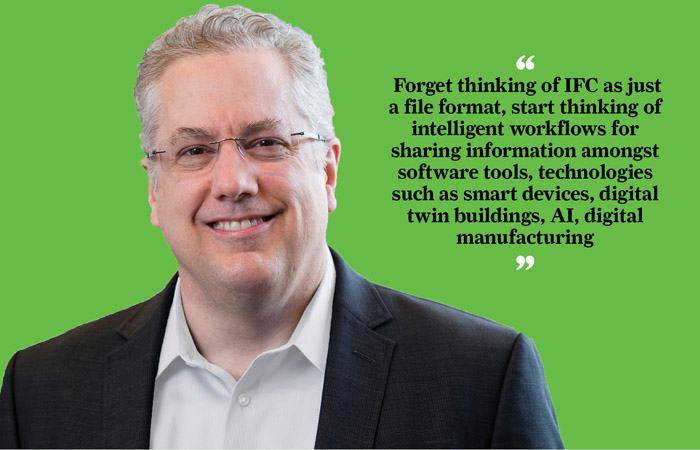With the London launch of ArchiCAD 23, AEC Magazine had the chance to catch up with Graphisoft’s new CEO of two months, Huw Roberts, to capture his thoughts on the company and the BIM market
Graphisoft was originally founded in 1982 by Hungarian software developer Gábor Bojár. Bojár was the head of a mathematical department in the Geophysical Institute of Budapest, where he developed terrain modelling software on microcomputers. Apple’s Steve Jobs saw the early developments in 2D/3D architectural CAD that Bojár had made. He was so impressed that he shipped him an Apple computer, which had to be smuggled into the country, as it was behind the Iron Curtain at the time. This development became ArchiCAD, the first desktop BIM system.
Since then Graphisoft was sold to Nemetschek, a holding company for many brands, such as Solibri and Maxon, and has gone on to be a key global player in the architectural movement from 2D drafting to 3D modelling. Now in its 23rd release, ArchiCAD runs on both Mac and PC and competes head on with Autodesk Revit.
Huw Roberts recently took over the reins of the company from Viktor Várkonyi, who has since moved up to become chief division officer at the Nemetschek Group. In his ten-year tenure as CEO, Várkonyi tripled the company’s revenues and took it into new regions, primarily in Asia and South America.
AEC Magazine has known industry veteran Huw Roberts for almost 20 years, as previously he was global VP of marketing for Bentley Systems’ portfolio of AEC products, from TriForma to MicroStation and Projectwise, and was responsible for forming strong partnerships in the industry. Roberts is a trained architect and still proudly keeps his licence to practice. He is a former chairman of the Technology in Practice committee at the AIA and prior to joining Graphisoft last year (initially as VP of Americas) he was Chief Marketing Officer at BlueCielo, a European CDE developer. He brings a lot of American marketing experience to the role.
AEC Magazine: What are your plans for Graphisoft?
Huw Roberts: I started with Graphisoft in September (2018) and was initially focussed on learning the company, learning our customer base and seeing how we position ourselves in the market. Two months ago I took over as CEO, so I’m still early in my observations, but we are going to keep our approach to business by continuing to focus on the core of what we’re great at and that’s delivering great software for architects and designers, expanding the capabilities of ArchiCAD and our commitment to OpenBIM.
The company is in a really good place; not just Graphisoft and ArchiCAD, but as a key component in the Nemetschek portfolio of companies. We have a broad range of technologies for the desktop, mobile and cloud, adding value across the AEC market. Looking at where we’re going to grow, we have to anticipate where the market is going and what will benefit our industry next and be ahead of that change.

AEC: What got you into the BIM world?
HR: Before I worked in the architectural software world, I was an architect and I am still an architect. I ran a studio in one of the largest US firms based in Philadelphia. I used to design hospitals, sports facilities, large and complex projects – and I pushed the available technology to its limits. My interest in technology grew and I got involved with all the professional organisations in my space, especially the AIA, in trying to work out best practices for how we should collaborate and share data between disciplines. I’m a strong believer in community and open standards. While at Bentley Systems, I continued this with international organisations like RIBA, Construction and Owner organisations, the Smart Geometry group and buildingSMART.
AEC: What are the key barriers to successful implementation of BIM?
HR: Being a global company we can see how there are different levels of success with and adoption of technology in all geographies, and we have the opportunity to see those different pieces and start connecting the dots. I like the William Gibson quote that ‘the future is already here, it’s just not evenly distributed’, and I think that’s certainly the case in our industry. There are fantastic things happening, but they’re spread out. Our job is to see the larger landscape and share that knowledge with our customers through our relationships and see how we can fold that back into the software to bring benefits to all our customers around the world. So in effect a lack of awareness or education is the main issue.
AEC: Graphisoft scores highly on customer satisfaction. What’s the secret?
HR: I think it’s central to Graphisoft’s culture to be customer focused. We’re not going to succeed by playing business games with our customers or trying to lock people into software. We’re not trying to manipulate the market with a business model. Our central focus is to understand what we can do to help our customers succeed. It’s actually fundamentally really refreshing to me, to see how dedicated the company is to that approach, across the team in Graphisoft HQ and around the world. I think that’s kind of a driving principle for us to just add value as our approach to opportunities in the market.
AEC: What changes will you make to the company?
HR: Graphisoft, as a company is strong, we are having good business success, we have good financial performance, good customer satisfaction, good growth -but perhaps we are not particularly publicly bold or proud of that. We don’t market strongly; we could better leverage that strength. I’ve been in this industry for 30 years and when I look at the numbers and I look at the status of ArchiCAD in the architectural BIM market as number one or number two in most of the major markets in the world and, in many of those number two spots, we are on a trajectory to take over number one.
I think it’s our job to actually leverage and build on that strength, and to promote that strength to validate our customer’s choice. We should do a better job of broadcasting and being proud about that, so we’re going to start cranking things up to 11 to go Spinal Tap on you!
In addition, while there’s a lot of really successful implementations of ArchiCAD in the professions, we need to see how we can accelerate this out to other users, and here maybe, the most powerful force is not actually the technology it’s the human brain, helping people learn from each other, understanding how to apply these technologies and methodologies. So we’re looking at aligning the learning offerings we could provide customers to where they are in the process – and delivering them on demand, in person, online in a large format, short format, just in time, all to help customers make the most from applying the technology
The other thing that I think is important to the industry (and I’m proud of the Graphisoft attitude) is support of OpenBIM workflows. The Nemetschek group at a recent buildingSMART international conference, held in Dusseldorf in March, helped drive through a set of principles an extension of the OpenBIM approach and philosophy to all the participating software companies that were there. This wasn’t just about software or APIs, but about the behaviour of the software companies. We all know that a software company could say “Yes we support IFC, it only takes 40 minutes to open that file in our software” That’s not real, that’s fake. That’s a checkbox on a marketing brochure, to pretend that you are supporting Open BIM.
Software firms have to actually commit to it and make it practical and promote it as the preferred method of sharing, rather than something a software company feels it has to do. We propose that members of the buildingSMART organisation internationally commit to that approach. Forget thinking of IFC as a just a file format, start thinking of intelligent workflows for sharing information amongst software tools, technologies such as smart devices, digital twin buildings, AI, digital manufacturing. There’s all sorts of things beyond BIM models that need the same open mindset across the industry if it’s going to advance properly.

AEC: Any particular areas where BIM workflows needs to do better?
HR: As you move information through a building’s lifecycle there are these discontinuity points where information is ‘thrown over the wall’ to the next phase or the next participant in the design. There are all sorts of reasons for this; legal, process, and technical reasons through all the phases as information moves between subcontractors, designers, engineers, it goes out to bid and tender, comes back again, then it drops down to the general contractor and the construction team, and finally gets to the owner for operations. It’s a very well understood and inefficient challenge across our industry.
I think that the goal is to try to enable as integrated teamwork as possible. Achieving full workflow transparency and free flow of information at these points in the process and to solve these challenges will require a combination of technologies to find a solution in conjunction to changes in the legal and contract‘ing systems, especially concerning liability. Most of the thinking in this regard has been done at a document level bid documents, design documents, engineering calculations, building codes, whatever… but these big transaction dumps are a big kind of block to information flow.
Our vision is to not only think about the problem at that level, to not think of these big monolithic transactions as the primary method of getting asset information through that lifecycle. We think it’s not just at a project level, or even at an element level. Our approach is to make the information exchanges at the attribute level and to give customers dynamic control in a practical and effective way.
AEC: There have been changes within Nemetschek with a more coordinated front at exhibitions. What’s driving this?
HR: To date, the Nemetschek Group has kind of been a holding company for an array of different businesses that operate on their own and we are still discreet and separate businesses. However, simultaneously to my taking over as CEO at Graphisoft, we’ve done a reorganisation of the Nemetschek Group which better integrates the brand CEOs for better collaboration. It will allow us to figure out our synergies between the brands with a focus on our shared customers. We can better discover areas that are not internally competitive where we can add value and share information, we can share our roadmaps and some of our ‘secrets’ a little bit more than we can with the outside world. We’re going to take advantage of this in a big way. Of course, we also want to continue expanding our integration with companies that are not in the Nemetschek Group as well.
AEC: What will be your approach to development?
HR: On the first day I was in Budapest, Gábor Bojár, the company founder, gave me a copy of his book about the history of Graphisoft and very proudly highlighted that Graphisoft invented BIM and so we are founded on innovation. But 1984 is a long time ago and we are still innovating at a healthy pace. Great things are coming! I want to look at how we can accelerate that and how we can make sure innovation meets and anticipates customers’ needs.
We’re going to be tackling this on three fronts. First, within the product, where we have a great team understanding the feedback wishes from our customers and the market, and we will continue advancing the product as you are familiar with. Second, we have an exciting set of new technologies which we will be presenting at our Key Customer Conference in Vegas in June. And thirdly, we are going to do a lot more with our Labs initiatives, looking at all sorts of interesting areas like IoT, Artificial Intelligence, and more where there are some amazing potentials. It’s all about us learning how we can best apply these disruptive opportunities in useful ways to add value to what customers are trying to achieve. So, our job is to continually add value to what we offer our customers so that they can be successful in producing great buildings and competing more effectively. We do that by continually learning about new technologies, new industry trends, new challenges and opportunities architects face, and delivering innovations that really add value to our customers. I’m very excited for the future we will be building together.
If you enjoyed this article, subscribe to our email newsletter or print / PDF magazine for FREE






